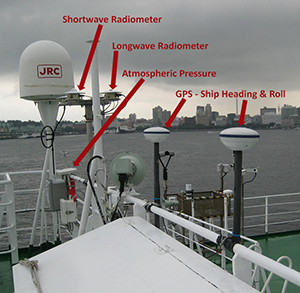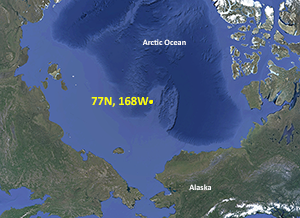A seat in the Arctic
PSL to measure air-sea interactions as part of study to improve midlatitude weather forecasts
August 27, 2014
In a remote area north of Alaska in the frigid Arctic Ocean (at 77N, 168W), the Japanese research ship Mirai will be "seated" for 20 days to collect a variety of observations. As part of the “MR14-04” research expedition, a suite of instruments from the NOAA Earth System Research Laboratory’s Physical Sciences Laboratory (PSL) will measure the exchange (or flux) of heat, water vapor, and momentum between the atmosphere and the ocean. Organized by the National Institute of Polar Research in Japan, the main focus of the cruise is to study the biochemical coupling between the air and sea under stormy conditions, and understanding how arctic atmospheric soundings might improve mid-latitude weather forecasts.
"There is considerable interest in the atmospheric connection between the Arctic and mid-latitudes,” says Byron Blomquist, a CIRES researcher at PSL, "but currently, the amount of arctic sounding data available for assimilation into forecast models is limited."
Blomquist is responsible for monitoring PSL's measurements and maintaining the equipment, which is mounted high atop the ship’s main mast and on the pilot house.
The other measurement systems aboard the ship include a dual-polarization C-band Doppler radar, lidar, ceilometer, disdrometers, a micro-rain radar, a sky radiometer, surface meteorology and radiation sensors, sea surface temperature sensors, an ocean temperature/salinity profiling and sampling array (CTD), oceanic turbulence sensors, and analyzers for atmospheric and oceanic carbon dioxide and methane concentrations. In addition, there will be up to eight weather balloon launches per day.
“PSL’s collaboration will help quantify the important exchange of heat between the ocean and atmosphere,” says Blomquist, “at the peak of the summer melt season and subsequent onset of sea-ice regrowth in October."
The observations from the Mirai will complement the SWERUS-C3 Arctic research cruise already underway on the Swedish icebreaker Oden, and will also provide important background for a scheduled 2015 research cruise on the R/V Sikuliaq targeting wave-sea ice interactions.
The Mirai departs Dutch Harbor, AK on August 30th and returns to port on October 10th in Yokohama, Japan.
Contacts
- Byron Blomquist, CIRES Researcher at NOAA/ESRL Physical Sciences Laboratory, 303-497-6287
- Barb DeLuisi, Communication Specialist, NOAA/ESRL Physical Sciences Laboratory, 303-497-4233


